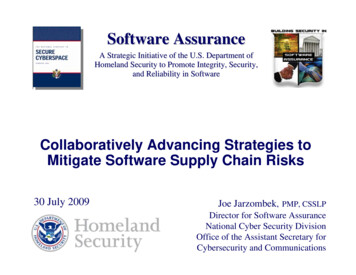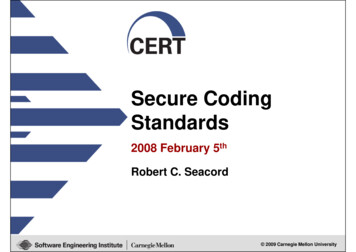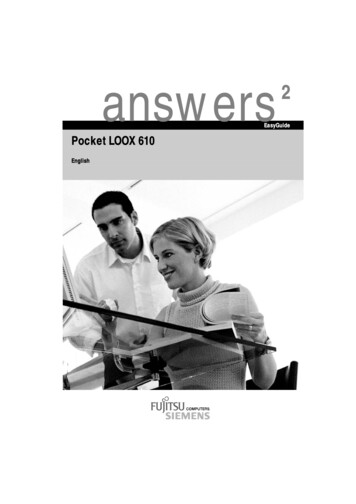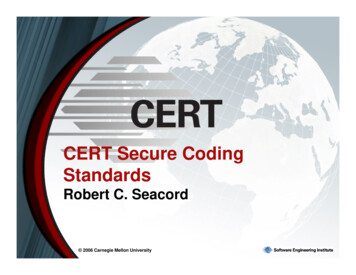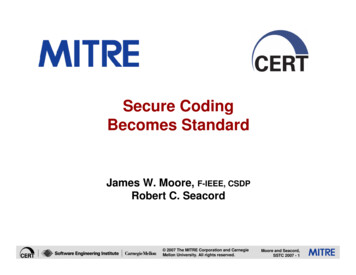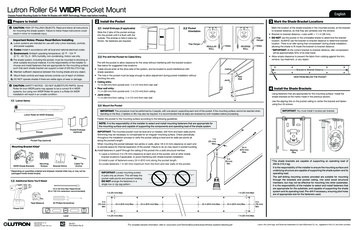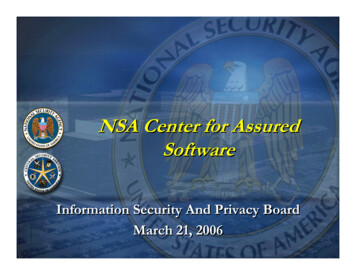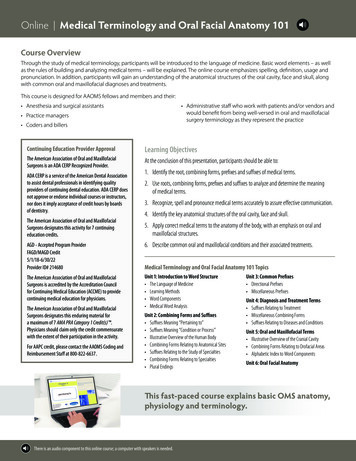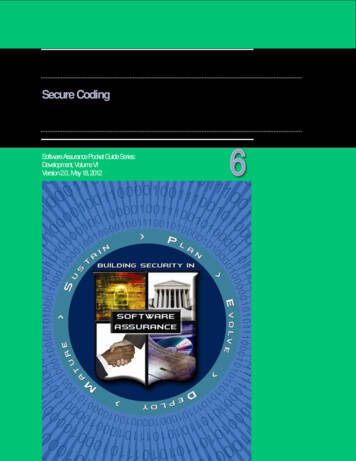
Transcription
SOFTWARE ASSURANCE IN ACQUISITION: MITIGATING RISKS TO THE ENTERPRISESecure CodingSoftwareAssurancePocket Guide Series:Development, VolumeVIVersion2.0., May 18, 2012ii
Software Assurance (SwA) Pocket Guide ResourcesThis Guide provides a ground-level resource for creating code that is secure and operates as expected. As part of the SoftwareAssurance (SwA) Pocket Guide series, this resource is offered as informative use only; it is not intended as directive orcomprehensive. Rather it references and summarizes material in the source documents that provide detailed information. Whenreferencing any part of this document, please provide proper attribution and reference the source documents, when applicableThis volume of the SwA Pocket Guide series focuses on secure coding principles and practices that mitigate vulnerabilities andsupport overall software security. It describes basic concepts and principles for writing secure code. It addresses preparationsfor writing secure code, secure coding principles, secure coding practices, secure memory and cache management, secure errorand exception handling, and common coding mistakes. It provides questions for managers in development and for procurementorganizations to assess coding. The answers to the questions can help them establish whether the teams responsible for thedelivery of software use the requisite practices: practices that contribute to the overall security of software.The back of this pocket guide contains limitation statements, and a listing of additional topics covered in the SwA Pocket Guideseries. All SwA Pocket Guides and SwA-related documents are freely available for download via the SwA Community Resourcesand Information Clearinghouse at ementsThe SwA Forum and Working Groups function as a stakeholder mega-community that welcomes additional participation inadvancing software security and refining SwA-related information resources that are offered free for public use. Input to all SwAresources is encouraged. Please contact Software.Assurance@dhs.gov for comments and inquiries. For the most up to datepocket guides, check the website at https://buildsecurityin.us-cert.gov/swa/.The SwA Forum is a multi-disciplinary community composed of members of the government, industry, and academia. Meetingquarterly in SwA Forum and Working Groups, the community focuses on incorporating SwA considerations in acquisition anddevelopment processes relative to potential risk exposures that could be introduced by software and the software supply chain.Participants in the SwA Forum’s Processes & Practices Working Group contributed to developing the material used in this pocketguide in an effort to encourage application of SwA practices throughout the Software Development Lifecycle (SDLC).Software Assurance Pocket Guide Series:Development Volume VI – Version 2.0, , May 18, 2012Secure Coding1
Information contained in this pocket guide is primarily derived from “Enhancing the Development Life Cycle to ProduceSecure Software.” Information for that and other references is listed in the Resources box that follows.The Processes & Practices Working Group would like to thank the Department of Homeland Security (DHS), National CyberSecurity Division’s Software Assurance team for substantial support in completing this guide and related SwA documents.Additional thanks for providing material and input goes to Jason Grembi from Sterling Connect LLC, Robert Secord of theCarnegie Mellon University, Software Engineering Institute, David Wheeler from the Institute for Defense Analysis, Art Conklinfrom the University of Houston and the Workforce Education and Training Working Group, and Keith Turpin for the OWASPSecure Coding Practices Quick Reference Guide.Resources»BuildSecurityIn Coding Practices resources. 25 June 2010. United States Government. Departmentof Homeland Security. 28 July 2010 cles/knowledge/coding.html .»BuildSecurityIn Coding Rules resources. 16 May 2008. United States Government. Department ofHomeland Security. 28 July 2010 s/home.html .»CERT Secure Coding Standards. 28 August 2010. Carnegie Mellon University SoftwareEngineering Institute/Computer Emergency Response Team [CERT]. 31 August 2010 https://www.securecoding.cert.org/ .»“Fundamental Practices for Secure Software Development: A Guide to the Most Effective SecureDevelopment Practices in Use Today.” SAFECode.org. Ed. Stacy Simpson. 8 October 2008. TheSoftware Assurance Forum for Excellence in Code [SAFECode]. 13 July 2010 http://www.safecode.org/publications/SAFECode Dev Practices1008.pdf .»“Software Security Assurance: State-of-the-Art Report (SOAR).” Goertzel, Karen Mercedes; et al.Information Assurance Technology Analysis Center [IATAC]. 31 July 2007. 3 August 2010 http://iac.dtic.mil/iatac/reports.jsp#SOAR .»Enhancing the Development Life Cycle to Produce Secure Software, Goertzel, Karen Mercedes,Theodore Winograd, et al. Version 2.0. Rome, New York: United States Department of DefenseData and Analysis Center for Software, July 2008. https://www.thedacs.com/get pdf/DACS358844.pdf .»“Key Practices for Mitigating the Most Egregious Exploitable Software Weaknesses V 1.3.”Community Resources and Information Resources. 24 May 2009 Version 1.3. United StatesGovernment. Department of Homeland Security. 13 July 2010 https://buildsecurityin.us-cert.gov/swa/pocket guide series.html#development .»“Writing Secure Code.” Microsoft. Microsoft Security Developer Center. 28 July 2010 .aspx .»The Security Development Lifecycle: SDL: A Process for Developing Demonstrably More SecureSoftware, Michael Howard and Steve Lipner. Microsoft Press (May 31, 2006)»“OWASP Comprehensive, Lightweight Application Security Process (CLASP) project.” OWASP.org.3 July 2009. The Open Web Application Security Project [OWASP]. 19 July 2010 http://www.owasp.org/index.php/Category:OWASP CLASP Project .»“OWASP Secure Coding Practices Quick Reference Guide.” OWASP.org. November 2010 Version2.0. . The Open Web Application Security Project [OWASP]. 17 November 2010 http://www.owasp.org/index.php/OWASP Secure Coding Practices - Quick Reference Guide »SANS Software Security Institute. SANS. 20 September 2010 http://www.sans-ssi.org/ .»CWE/SANS TOP 25 Most Dangerous Software Errors. SANS. V2.0 February 16, 2010, http://www.sans.org/top25-software-errors/ .Software Assurance Pocket Guide Series:Development Volume VI – Version 2.0, , May 18, 2012Secure Coding2
Resources»Secure Coding in C and C . Seacord, Robert C. Upper Saddle River, NJ: Addison-Wesley.September 2005.»“Secure Coding Guide.” Mac OS X Reference Library. 12 February 2010. 28 July 2010 Conceptual/SecureCodingGuide/SecureCodingGuide.pdf .»“Enhancing the Development Life Cycle to Produce Secure Software.” United States Government.Department of Homeland Security - Software Assurance Forum Process and Practices WorkingGroup. The Data & Analysis Center for Software [DACS]. October 2008 Version 2.0. United StatesGovernment. Defense Technical Information Center. 24 June 2010 http://www.thedacs.com/techs/enhanced life cycles/ .»Secure Programming for Linux and Unix HOWTO -- Creating Secure Software. Wheeler, David A. 3March 2010 Version 3. 20 Dec 2010 http://www.dwheeler.com/secure-programs/ .OverviewCode that is not properly protected can allow an intruder to view sensitive information, change or delete valuable or importantdata, deny service, run programs, or plant malicious code within a software system. Because of the risks associated withsoftware and the supply chain, it is critically important that precautions be taken through every process in the softwaredevelopment lifecycle.Secure coding is a prerequisite for producing robustly secure software. The development of secure software is a complexendeavor and requires a systematic process. The most commonly exploited vulnerabilities are seemingly easily avoidabledefects in software. Producing secure code is not an absolute science because it depends on a wide range of variables, some ofwhich cannot be easily or accurately measured. Such variables range from the language or platform being used to the nature ofthe software being developed or the data with which the software is meant to work. This guide does not prescribe answers for allpossible situations. Rather, it discusses fundamental practices for secure coding, and lists resources that provide additionalinformation about these practices. Using these resources, practitioners can write more secure code for their particularenvironment. Secure coding fundamentals and tips include:»Preparing to Write Secure Code . 4Choose a Language with Security in Mind . 4Create a Secure Development Process . 6Create an Application Guide . 6Identify Safe and Secure Software Libraries . 7Secure Coding Principles . 8o Keep Code Small and Simple . 8o Make Code Backward and Forward Traceable . 9o Code for Reuse and Maintainability . 9o Follow Secure Coding Standards and/orGuidelines . 9o Use Compiler Security Checking and Enforcement . 10o Avoid Security Conflicts Arising Between Nativeand Non-Native, Passive and DynamicCode . 11o Review Code During and After Coding . 12Secure Coding Practices . 14o CWE/SANS Top 25 Error List/OWASP Top 10 List. 14o Validate and Encode Input . 14oooo»»Software Assurance Pocket Guide Series:Development Volume VI – Version 2.0, , May 18, 2012Secure Coding3
Filter and Sanitize Output and Callouts .16Minimize Retention of State Information .16Do Not Allow Unauthorized Privilege Escalation .17Leverage Security through Obscurity Only as anAdditional Deterrence Measure .17o Use Strongly Typed Parameterized Queries .17o Incorporate Interprocess Authentication .17o Leverage Attack Patterns .18o Implement Encryption and Hashing .18o Protect Sensitive Information .19o Disable Debugging Tools Prior to Deployment .19Secure Memory and Cache Management .20o Limit Persistent Memory Caching .20o Allocate Memory and Other Resources Carefully .21Secure Error and Exception Handling .21o Integrate Anomaly Awareness .23o Incorporate Runtime Error Checking and SafetyEnforcement .23o Use Event Monitors .23o Fail Securely .23What to Avoid .24o Do Not Use Deprecated or Insecure Functions .24o Do Not Use Filenames in an Improper Manner .25Questions to Ask Software Developers .25Conclusion .27oooo»»»»»Preparing to Write Secure CodeBefore writing code, the development team must first determine how they plan to accomplish their assigned task. It is importantto remember that writing secure code needs the support of secure requirements, architecture, and design. To find more on thesetopics, reference “Requirements and Analysis for Secure Software” and “Architecture and Design Considerations for SecureSoftware.” Both of these documents are part of the SwA Pocket Guide Series.Choose a Language with Security in MindThe choice of a programming language is an important factor in software security. In many cases, legacy code, the available skillsets, or customer requirements, including the environment, may restrict programming language options. When evaluating andselecting the programming language(s), you should ask these key security-relevant questions:»»»»Which languages have your programmers used? Programmers are likely to make more errors when developing inlanguages they have little experience using.Does the language help or inhibit the development of secure code?What secure coding standards are available for the language (if any)?What security issues exist in the language? What mitigation strategies exist? How effective are they?Weighing language choices: In many situations, the choice of language can directly affect the system’s security. The mostprominent example is the effect of array bounds checking, which Java provides but C does not. Although most modern Ccompilers support runtime bounds checking, this feature (or lack thereof) has left a legacy of buffer-overflow-based vulnerabilitiesin web servers, operating systems, and applications. Java is without these specific vulnerabilities, but may not be appropriate forSoftware Assurance Pocket Guide Series:Development Volume VI – Version 2.0, , May 18, 2012Secure Coding4
environments where performance and a small footprint are important (such as embedded devices and smart cards). A JavaVirtual Machine (JVM) may introduce too much strain on the system, resulting in potential denials of service. It is security issuessuch as these that make it important to have an understanding of which weaknesses exist or are more likely to appear based onthe choice of language.“Safe” languages: Most “safe” languages (or language variants) are intended to help avoid problems with buffers, pointers, andmemory management. The bounds-checking interfaces developed by Microsoft and included in the emerging C1X standard canmitigate vulnerabilities resulting from improper string management in existing C programs. If the program is expected to operatein a particularly exposed environment, on cell phones, or on the web, use a language that includes its own security model andself-protecting features (e.g., Java, Scheme, Categorical Abstract Machine Language). Alternatively, implement a virtual machineon the host system to contain and isolate the program.Advantages of static typing: Languages with static typing such as Java, Scheme, MetaLanguage (ML), F#, and Ada ensurethat operations are only applied to values of the appropriate type. Type systems that support type abstraction let programmersspecify new, abstract types and signatures for operations. Such typing prevents unauthorized code from applying operationsinappropriate for the given values. In this respect, type systems, like software-based reference monitors, go beyond operatingsystems in that they can be used to enforce a wider class of system-specific access policies. Static type systems also enableoffline enforcement through static type checking rather than checking based on each specific instance of operation. This allowsthe type checker to enforce rules that are difficult to enforce with online techniques.Built-in security mechanisms: Newer languages, such as C# have a variety of security mechanisms built into the languageincluding type safe elements, code access security, and role-based security included via the .NET framework. Although the .NETframework and C# contain many elements that can assist in secure development, it is still incumbent on the development team toproperly use these elements. It is important to note that there may be certain features of the language that will provide moresecurity; however, other aspects may open new security vulnerabilities. Therefore, it is necessary to stay informed on anyvulnerabilities or issues that may arise from using the selected language.Some languages can reduce the damage that un-trusted programs can do by limiting the system calls that the program caninvoke. Perl does this through its “taint mode,” which only allows user-supplied input that is explicitly specified as “untainted” bythe programmer [Birznieks 1998]. Java provides the JVM as a “sandbox” and does not allow an un-trusted program to act outsidethe JVM. For example, un-trusted Java applets cannot create a new process or read/write to the local disk [Venners].Don’t rely on language choice alone: While picking a secure programming language is important, many developers make themistake of assuming that a secure language is a panacea for security vulnerabilities. Regardless of the language used,developers with little to no knowledge of secure coding will deliver insecure code; therefore, there needs to be a securedevelopment process [Rook 2010].Resources»CGI/Perl Taint Mode FAQ. Birznieks, Gunther, 3 June, 1998. 20 July 2010 http://gunther.web66.com/FAQS/taintmode.html .»“Your choice of programming language doesn’t matter, they are all insecure!” Rook, David. SecurityNinja: Security Research, News & Guidance. Realex Payments. 15 October 2010. ter-they-are-all-insecure .»United States Government. Department of Homeland Security - Software Assurance Forum Processand Practices Working Group. “Enhancing the Development Life Cycle to Produce Secure Software.”The Data & Analysis Center for Software [DACS]. October 2008 Version 2.0. United StatesGovernment. Defense Technical Information Center. 24 June 2010 http://www.thedacs.com/techs/enhanced life cycles/ .»“Java's security architecture.” Venners, Bill. JAVAWORLD. 1 August 1997. 20 July 2010 8-hood.html .Software Assurance Pocket Guide Series:Development Volume VI – Version 2.0, , May 18, 2012Secure Coding5
Create a Secure Development ProcessSecure software development is a process that involves many elements from requirements through design, coding and testing. Akey element in the process is the way information passes between the different teams during software construction. This processmust support secure coding efforts. [Howard 2006]The secure development lifecycle defines process elements for the entire development effort from the very beginning to the end.With respect to the coding process, the typical elements defined include:»»»»»»Defined coding standardsCompiler settings for secure codingSource code analysis tools and usageApproved and banned functionsSecure coding checklistSecurity gate checklistsThe primary purpose of the secure development lifecycle process is to engage the project management effort into the overallcoordinated effort. This is done to ensure the software meets the complete set of requirements—including security requirements.Expecting the development team to produce secure code without the coordinated efforts of all the other parties involved in theeffort is unrealistic. Many security issues result not from syntactic errors, but from design issues. Proper coordination betweenthe teams is the primary function of the secure development lifecycle process. A prime example of this cross-teamcommunication comes in the form of Threat Modeling. The threat modeling technique analyzes potential threats to a system anduses the results to design mitigations into the product. This requires communication between several teams, but results insoftware that embodies security thinking, thus thwarting potential threats. Additional information regarding coding standards andguidelines is discussed as part of the “Follow Secure Coding Standards and/or Guidelines” section.For more information regarding secure software design, please reference “Architecture and Design Considerations for SecureSoftware,” which is available in the SwA Pocket Guide Series library.Create an Application GuideBefore the development team can start the coding process, the organization must establish a policy in an application guide that isclear, understandable, and comprehensive enough to help other programmers write the specified code. This way any developercan easily maintain the code. The application guide should contain the following information [Grembi, 2008]:»»»»»»»»Where to get specific software (i.e. URL address, servers)Where to install software (directory structure, hard drives, servers)Where to find license informationWhere to find deployment instructionsHow the software is tested and what tools to useWhere to push code into production (server names, IP addresses)Procedures for checking in and checking out codeIdentification of language coding standardsConsistent code is fundamental; however, it is not sufficient for achieving secure code. By following the guide, the developerscan ease readability and increase the likelihood of a healthy teamwork. If created correctly, this guide can be used throughoutthe organization. While the process may need to adjust to the requirements of different projects or departments, this guide shouldhelp disseminate and enforce code development guidelines throughout the organization.Software Assurance Pocket Guide Series:Development Volume VI – Version 2.0, , May 18, 2012Secure Coding6
Resources»Secure Software Development: A Security Programmer’s Guide. Grembi, Jason. Boston: CourseTechnology, Cengage Learning. 2008.»The Security Development Lifecycle: SDL: A Process for Developing Demonstrably More SecureSoftware, Michael Howard and Steve Lipner. Microsoft Press (May 31, 2006)Identify Safe and Secure Software LibrariesA variety of safe/secure libraries have been developed for various languages and purposes. Many of these libraries have beendeveloped for the C and C programming languages to provide replacements for standard library functions that are prone tomisuse.Types of Secure Libraries: Significant attention should be given to the sourcing of these libraries. It is often unfeasible forteams to search the libraries for tampered code; therefore, it is important that the files come from a trusted source. The definitionof a trusted source depends on the team and the software being developed. Examples of libraries to consider are:»»»»Computer Emergency Response Team’s (CERT’s) managed string library [Burch 2010] was developed in response tothe need for a string library that can improve the quality and security of newly developed C-language programs whileeliminating obstacles to widespread adoption and possible standardization. As the name implies, the managed string libraryis based on a dynamic approach; memory is allocated and reallocated as required. This approach eliminates the possibilityof unbounded copies, null-termination errors, and truncation by ensuring that there is always adequate space available forthe resulting string (including the terminating null character).SafeInt is a C template class written by David LeBlanc [LeBlanc 2004]. SafeInt tests the values of operands beforeperforming an operation to determine whether errors might occur. The class is declared as a template, so it can be usedwith any integer type. SafeInt is currently used extensively throughout Microsoft, with substantial adoption within Office andWindows. If you are compiling for only the Microsoft compiler, a very similar version is now available with Visual Studio2010. It can be used with any compiler that has good template support, and is known to work on Visual Studio 7.1 or later.Open Web Applications Security Project’s (OWASP) Enterprise Security API (ESAPI) simplifies many security taskssuch as input validation or access controls [Melton 2009].AntiXSS libraries are available for web applications. AntiXSS libraries focus on preventing Cross Site Scripting (XSS)attacks. These AntiXSS libraries, at a minimum, allow the HTML-encoding of all output derived from un-trusted input.Examples include the OWASP PHP AntiXSS Library and the Microsoft Anti Cross Site Scripting Library [SAFECode 2008].Securing the libraries: After picking a secure library to work with, it is important to make sure that it stays secure. In the case ofJava JAR files, it is easy to un-JAR the file, tamper with the class, and then re-JAR the file. When a problem is found, it couldtake weeks or months to determine that the problem is in the JAR file. For this reason libraries should be placed in a securedirectory, with limited access rights, to make sure they are not tampered with [Grembi 2010]. The goal is not to make the libraryimpossible to repack, but to limit who can do it.Code signing: Code signing is a technology that can be employed to ensure that libraries and functions are not tampered with orchanged. Methods for ensuring code integrity before use include Authenticode, strong naming, and Windows Side by Side(WinSxS). Code signing is also available in open-source code library tools, such as Mercurial and GIT. The key takeaway is thatthe development team needs to define and follow an appropriate code-signing strategy as part of secure coding.Centralize code libraries: Store the project’s libraries as well as the rest of the project’s code base in a control managedrepository. A code repository allows for all of the project’s code to be stored in a central place and to allow changes to bemanageable. A security advantage to this is that it makes it easy to backup the entire code base and retrieve it later if the code isSoftware Assurance Pocket Guide Series:Development Volume VI – Version 2.0, , May 18, 2012Secure Coding7
damaged [Grembi 2010]. Having the code in one place also allows the development team to assert control over who can accessthe code base.Resources»“Specifications for Managed Strings, Second Edition (CMU/SEI-2010-TR-018).” Burch, Hal, Long,Fred, Rungta, Raunak, Seacord, Robert C., & Svoboda, David. Pittsburgh, PA: SoftwareEngineering Institute, Carnegie Mellon University,2010 0tr018.cfm .»“Fundamental Practices for Secure Software Development: A Guide to the Most Effective SecureDevelopment Practices in Use Today.” SAFECode.org. Ed. Stacy Simpson. 8 October 2008. TheSoftware Assurance Forum for Excellence in Code [SAFECode]. 13 July 2010 http://www.safecode.org/publications/SAFECode Dev Practices1008.pdf .»“Secure Processing”. Grembi, Jason. Software Assurance Community Resources and InformationClearinghouse. 27 September 2010. 21 October 2010. ns 2010 10/01 Monday/grembi/SecureProcessing.pdf .»ISO/IEC TR 24731-1. Extensions to the C Library, — Part I: Bounds-checking interfaces. Geneva,Switzerland: International Organization for Standardization, April 2006.»ISO/IEC TR 24731-2. Extensions to the C Library, — Part II: Dynamic Allocation Functions. Geneva,Switzerland: International Organization for Standardization, April 2010.»Integer Handling with the C SafeInt Class. LeBlanc, David. 2004. http://msdn.microsoft.com/library/default.asp?url /library/enus/dncode/html/secure01142004.asp .»“The OWASP Top Ten and ESAPI.” Melton, John. John Melton’s Weblog: Java, Security andTechnology. 3 January 2009. 4 August 2010 en-and-esapi/ .»“OWASP Enterprise Security API.” OWASP.org. 2 July 2010. The Open Web Application SecurityProject [OWASP]. 4 August 2010 http://www.owasp.org/index.php/Category:OWASP Enterprise Security API .Secure Coding PrinciplesKeep Code Small and SimpleThe smaller and simpler the code base, the easier it will be to verify the security of the software. The number of flaws in the codethat implements high-consequence functions can be reduced significantly by decreasing the size of the source code modulesthat implement those functions.Ways to Shrink and Simplify Code»»Ensure that the software contains only the functions that are required or specified. Adding unnecessary functions increasesthe attack surface of the software and raises the likelihood of the software being broken.Break large and/or complex functions into smaller, simpler functions whenever possible. This will make the system easier tounderstand and document, thus making it easier to verify the security and correctness of the individual component and thesystem as a whole.Software Assurance Pocket Guide Series:Development Volume VI – Version 2.0, , May 18, 2012Secure Coding8
»»Build the system so that it has as few interdependencies as possible. This ensures that any process, module, or componentcan be disabled or replaced without affecting the operation of the system as a whole.Encapsulate to limit the revealing (leaking) of sensitive information or externally inducing interference.Consideration should also be given to the tradeoff between size and simplicity. Breaking functions into too many smallerfunctions can make it difficult to see how the functions work together.Make Code Backward and Forward TraceableWhere practical, make it easy to trace each requirement to its expression in the design to its manifestation in the code. It shouldalso be possible to derive each requirement and design element from its manifestation in the code.For more information on developing secure requirements, such as use cases and misuse case, please reference “Requirementsand Analysis for Secure Software” and “Architecture and Design Considerations for Secure Software,” both of which can befound in the SwA
This volume of the SwA Pocket Guide series focuses on secure coding principles and practices that mitigate vulnerabilities and . Art Conklin from the University of Houston and the Workforce Education and Training Working Group, and Keith Turpin for the OWASP Secure Coding Practices Quick Reference Guide. . Engineering Institute/Computer .
